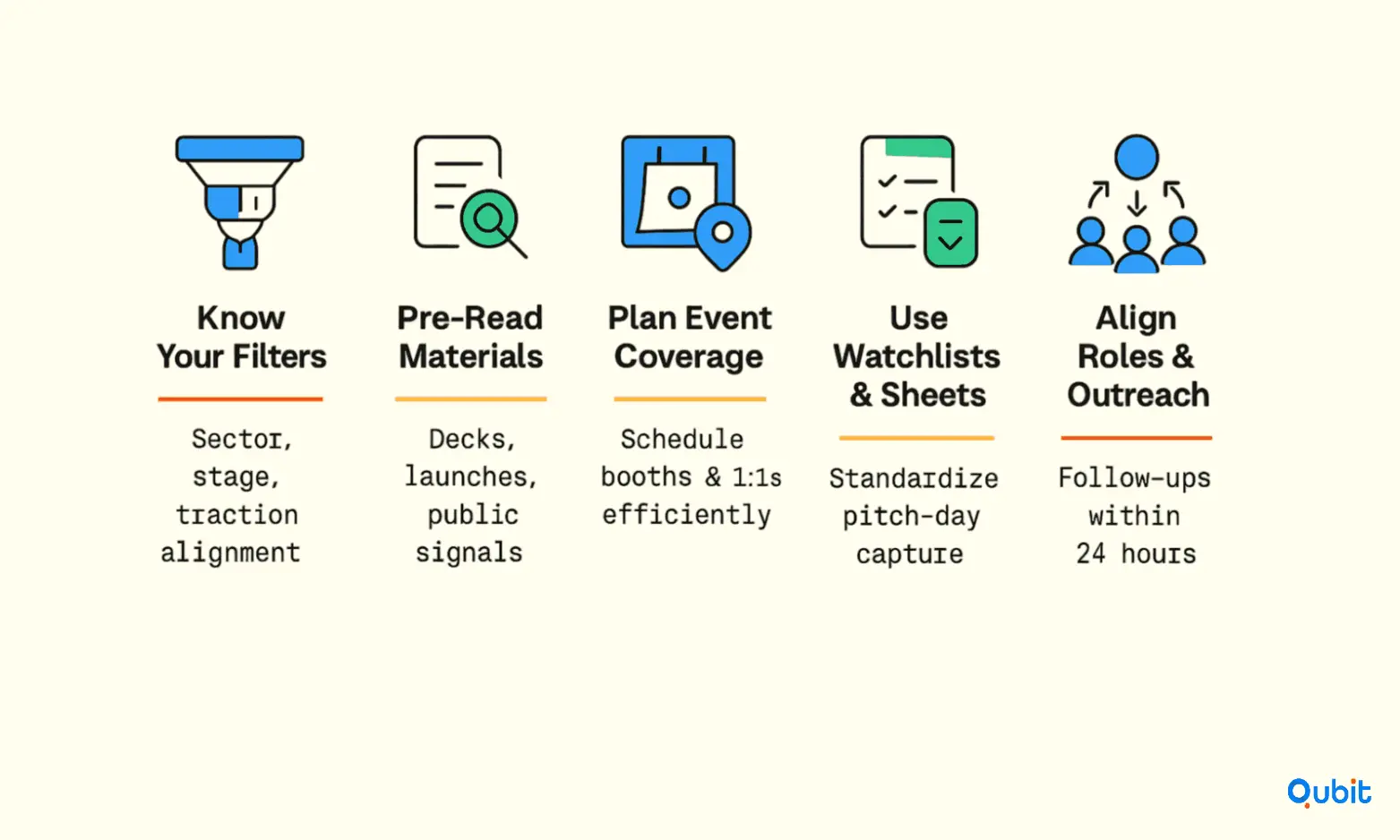Startup demo days have become a cornerstone for investors seeking high-potential opportunities. Research shows that approximately 80% of startups secure follow-on funding after participating in these events, underscoring their pivotal role in the funding ecosystem. For investors, demo days are not just about discovering innovative ideas—they’re about building relationships and identifying scalable ventures.
Your investment approach gains broader context through insights on how to do startup outreach for investors, which align with the wider tactics used in startup outreach. This blog aims to equip investors with actionable strategies to optimize deal flow during demo days, ensuring that no opportunity is missed.
Before Demo Day: Prepare to Find What You’re Looking For
Clarity beats volume, walk in knowing the sectors, stages, and traction profiles that match the investment thesis, then screen the cohort list against those filters to shortlist the most relevant teams for deeper attention and post-event follow-ups. Review founder materials and public signals in advance (decks, posts, launches), and frame a handful of decision-driving questions that validate market pain, wedge, and early evidence of pull to keep live interactions focused.

Expect limited time per pitch; pre-reading ensures the investor brain is primed to capture deltas and exceptions rather than basic facts during the presentation flow. If the event has booths or 1:1 areas, plan a divide-and-conquer schedule for partners or associates to cover more ground while preserving quality of first conversations and notes.
- Create a tiered watchlist and a 30-second company sheet to standardize on-the-day capture: problem, ICP, traction signal, moat hypothesis, and a single “why now” reason to care.
- Pre-draft outreach templates tied to thesis themes so follow-ups can go out within 24 hours with tailored references to each pitch, not generic messages.
- Align team roles and SLAs: who scans, who watches end-to-end pitches, who runs booth walk-ups, and who sends first follow-ups, so nothing slips.
Setting the Stage: Establishing the Demo Day Foundation
Startup accelerator programs like Y Combinator and Techstars have become pivotal in shaping the trajectory of early-stage ventures. These programs provide structured mentorship, resources, and access to networks that are essential for startups aiming to secure funding and scale effectively. Demo days, often the highlight of these programs, serve as strategic culmination points where months of preparation transform into tangible investor interest.
The growing reliance on accelerators underscores their role as gateways to early-stage capital and guidance. By offering a blend of mentorship and resources, they equip founders with the tools to refine their pitches and business models. Demo days are not just presentations; they are opportunities for startups to showcase their potential to a curated audience of investors and industry leaders.
Your perspective on identifying investment prospects is broadened by considering how to find startups through accelerators, which presents alternative pathways for discovering emerging ventures. These events highlight the importance of preparation, as startups leverage accelerator support to craft compelling narratives and demonstrate their market viability.
Market Trends and Evolution: Shifts in Demo Day Dynamics
The startup ecosystem is undergoing a transformation, with demo days reflecting broader market trends. One notable shift is the significant growth in funding rounds post-demo day, which saw an 18.4% increase in 2024 compared to 2023. This surge highlights the growing confidence investors have in startups emerging from accelerators.
AI-focused startups are playing a pivotal role in this evolution. With an increasing concentration of AI-driven ventures in accelerator batches, investor priorities are shifting. These startups are not only attracting larger funding rounds but also redefining evaluation criteria. Investors are now placing greater emphasis on scalability, technological innovation, and the potential for AI to disrupt traditional industries.
For a deeper understanding of how these trends are shaping investment strategies, explore the insights provided in the startup trend analysis for investors. This resource examines market patterns and their implications for identifying high-potential opportunities.
Additionally, the influence of AI startups on demo day dynamics has been widely discussed, as highlighted in a Fortune article on Y Combinator’s evolving accelerator ecosystem. These shifts underscore the importance of staying attuned to market changes to capitalize on emerging opportunities.
What to Watch For in Pitches: Investor Signal Checklist
Short demo-day slots reward clarity, narrative, and crisp evidence more than encyclopedic detail, so listen for concrete traction, believable distribution, and a credible path from pilot to paid rather than broad ambition alone.
Effective pitches communicate the core insight quickly, connect it to a specific buyer pain, show early proof (users, revenue, retention, partnerships), and ask directly for what they need next, making it easier for investors to engage constructively.
Visual economy and simple storytelling help memory formation under high pitch density; founders who anchor on a few big numbers and a clean flow are easier to champion internally after the day is over. Beware red flags: hand-wavy TAM with no wedge, feature tours instead of outcomes, or traction claims with no context on quality or repeatability
Investor quick-scan prompts:
- Problem and buyer: Is the pain acute, budgeted, and owned by a clear decision-maker in a specific segment?
- Traction quality: Are metrics tied to repeatable behavior (paid pilots, renewal intent, pipeline with ICP logos) rather than vanity numbers?
- Go-to-market: Do they demonstrate a distribution hypothesis that fits the buyer and cycle length (compliance, integrations, channels)?
- Moat vector: Is there defensibility in data, workflow lock-in, ecosystem position, or regulated know-how, not just model complexity?
- Why now: Is there a timing catalyst, technology, regulation, budget shift, or market behavior, that raises odds of near-term adoption?
Financial and Operational Preparedness: Crafting a Robust Funding Blueprint
A well-structured funding plan is the backbone of any successful startup. Detailed financial planning and operational due diligence are essential to ensure clarity and readiness for investors. Tools like Excel worksheets play a pivotal role in modeling funding scenarios and understanding dilution impacts, offering startups a clear view of their financial trajectory. Similarly, the SAFE (Simple Agreement for Future Equity) has become a standard instrument for early-stage funding, simplifying the investment process for both founders and investors. For those unfamiliar, the Y Combinator SAFE documents provide a comprehensive reference for implementing this approach effectively.
Real-world examples underscore the importance of these strategies. Atomic Industries, a standout accelerator graduate, demonstrated how meticulous preparation can lead to a seamless transition from demo day to securing funding. Likewise, Dashworks, a Y Combinator success story, exemplifies how robust financial modeling can enhance pitch readiness and attract investor confidence.
Your evaluation process is enriched by reviewing the best startup databases for investors, where detailed resource insights help clarify the methods for identifying viable startup opportunities. By combining these tools and insights, startups can craft a funding blueprint that not only attracts investors but also ensures long-term operational stability.
How Founders Should Craft Pitch According to Investor Profiles
Understanding your audience is the cornerstone of a successful investor pitch. Different investors prioritize different aspects of a business, making it essential to customize your presentation to align with their unique profiles. For instance, venture capitalists often seek compelling growth narratives, while angel investors may focus on the passion and vision behind your idea.
Combining qualitative storytelling with precise ROI metrics can create a pitch that resonates deeply. A well-crafted narrative builds emotional engagement, while data-driven insights establish credibility and trust. This dual approach not only captures attention but also addresses the specific concerns of your target investors.
Effective Demo Day Presentation Strategies: Delivering Impactful Pitches
Capturing attention during a demo day requires more than just presenting facts; it demands a blend of storytelling, preparation, and audience connection. This section explores actionable strategies to ensure your pitch leaves a lasting impression.
1. Craft a Compelling Narrative
A well-structured story can transform your pitch into an engaging experience. Start by identifying the core problem your startup addresses, then demonstrate how your solution uniquely solves it. Use real-world examples or customer success stories to make your narrative relatable and memorable.
2. Prioritize Rigorous Rehearsal
Preparation is the backbone of any successful presentation. Rehearse your pitch multiple times, focusing on timing, clarity, and delivery. Record yourself to identify areas for improvement, and seek feedback from trusted peers or mentors. This process ensures you’re confident and polished on demo day.
3. Engage Your Audience Actively
Interaction can elevate your pitch from a monologue to a conversation. Pose thought-provoking questions, incorporate visuals, or invite brief audience participation to keep attendees invested. Active engagement fosters a connection that makes your pitch stand out.
4. Maintain Authenticity
Authenticity builds trust. Speak with genuine enthusiasm about your startup’s mission and vision. Avoid overloading your pitch with jargon or overly rehearsed lines; instead, focus on conveying your passion and commitment.
Your analysis of potential investments is further informed by the discussion on how to find promising startups to invest in, which complements deal flow optimization strategies beyond demo day events.
By integrating these strategies, you can transform your demo day presentation into a powerful tool for securing investor interest and advancing your startup’s goals.
Investor Perspectives: Learning from Industry Leaders
Seasoned investors often emphasize the art of blending numbers with narratives. Robert Nicholls, a respected figure in the investment world, highlights the importance of balancing rigorous financial metrics with relatable storytelling. He believes that while data provides the foundation, a compelling narrative transforms it into a vision investors can connect with emotionally. This dual approach not only clarifies the opportunity but also builds credibility.
Elicia McDonald, a venture capital expert, underscores the role of authenticity in fostering trust. According to her, investors are more likely to engage when founders present their data transparently and pair it with genuine stories that reflect their mission and values. Authenticity, she argues, is the bridge between raw numbers and meaningful connections.
In-Room Tactics: How to Capture and Rank Fast
High-density demo days overload working memory, so use a standardized notation system that makes post-event triage objective: a 1–5 fit score, a 1–3 urgency score, and a one-sentence justification captured in real time during each pitch.
Record explicit questions that matter for a next meeting (e.g., “who owns budget,” “security posture,” “pilot-to-paid timeline”) rather than generic notes that won’t inform a go/no-go decision later. If there are booths or open-floor demos, visit top targets promptly after their slot to ask one decisive question and request a specific follow-up action (data room snippet, short product video, or quick intro to a customer reference).
When attending virtual or hybrid demo days, keep a split-screen setup with slides or product feeds on one side and structured notes on the other to preserve pace and accuracy.
- Time-box walk-ups to 5–7 minutes and exit clearly with a concrete ask and next step to avoid bottlenecks and missed meetings down the line.
- Tag notes with themes (e.g., “regulated buyer,” “PLG to enterprise,” “data network effects”) to enable quick cohort comparisons post-event.
- If co-attending, sync at mid-day huddles to recalibrate which companies deserve added in-person time based on the strongest signals seen so far.
Measuring Demo-Day ROI: What to Track and Why
Impressions and card scans don’t predict allocations; investors should track qualified replies, second meetings booked, conversion to diligence, and, over time, allocation wins attributable to the event. Qualitative signals matter too—founders referencing specific investor questions or asking for targeted help are stronger indicators than generic “let’s connect” replies that often evaporate. Within one week, run a short post-mortem to compare which narrative angles, sectors, or question patterns correlated with better meetings, and adjust the next event plan accordingly.

- Define success in advance: e.g., 10 qualified conversations, 5 second meetings, and 2 diligence processes initiated within 14 days, then score performance objectively against that bar.
- Document learnings from “near-misses” to improve future targeting and question quality—small improvements compound across a year’s event calendar.
- Build a lightweight template for demo-day notes and follow-ups so future events run on rails rather than reinvention.
Common Pitfalls to Avoid
Waiting days to follow up cedes ground to faster funds and confuses founders about investor interest, reducing response rates and momentum. Over-indexing on “story” without pinning down buyer, budget, and proof points leads to many pleasant conversations and few investable paths.
Taking undifferentiated notes or failing to assign owners results in missed meetings and lost recall, especially after high-volume events. Lastly, performing diligence in the hallway—overloading founders immediately with heavy asks—can backfire; sequence information requests to earn trust and conserve founder bandwidth.
A Simple, Repeatable Day-Of Workflow
- Before: shortlist, question templates, calendar blocks for booths, and pre-drafted outreach snippets.
- During: live scorecards, one-sentence summaries, decisive booth questions, and mid-day recalibration with teammates.
- After: 24-hour tailored follow-ups, 48–72-hour second meetings, and a one-week review with metrics and narrative learnings.
Post-Demo Day Engagement: Sustaining Investor Momentum
Demo day may mark the culmination of your pitch preparation, but the real work begins afterward. Maintaining investor enthusiasm requires a structured approach to engagement. Start by crafting personalized follow-up communications that reinforce the key points of your presentation. These messages should not only express gratitude but also provide updates on your progress and next steps.
Scheduling one-on-one meetings with interested investors is equally critical. These sessions allow you to address specific questions, build rapport, and demonstrate your commitment to transparency. During these interactions, actively document feedback to refine your pitch and address any concerns.
By systematically nurturing these relationships, you can transform initial interest into firm commitments. Consistent communication and responsiveness signal professionalism, ensuring your startup remains top of mind for potential investors.
Conclusion
Securing investments after a demo day requires more than just a compelling presentation. By focusing on robust financial preparedness, delivering tailored pitches, and maintaining consistent engagement, startups can transform initial enthusiasm into long-term investor commitments. Clear, data-driven narratives, when paired with authenticity, not only build trust but also resonate deeply with potential investors.
Now is the time to act on these insights. If you're looking to secure the right investors, our Investor Outreach service at Qubit Capital can connect you with promising leads. Let’s take your demo day strategy to the next level.
Key takeaways
- Demo days are pivotal for investor deal flow, with approximately 80% of companies securing follow-on funding.
- Accelerator programs provide the foundation and mentorship necessary for demo day success.
- Market trends reveal an 18.4% increase in capital raised and a significant shift toward AI-focused startups.
- Robust financial preparedness paired with authentic storytelling is essential for impactful pitches.
- Effective post-demo day engagement transforms investor interest into tangible commitments.
Frequently asked Questions
What should I include in my startup demo day pitch?
Include a compelling narrative that outlines the problem, solution, and impact, supported by clear financials and investor appeal.






